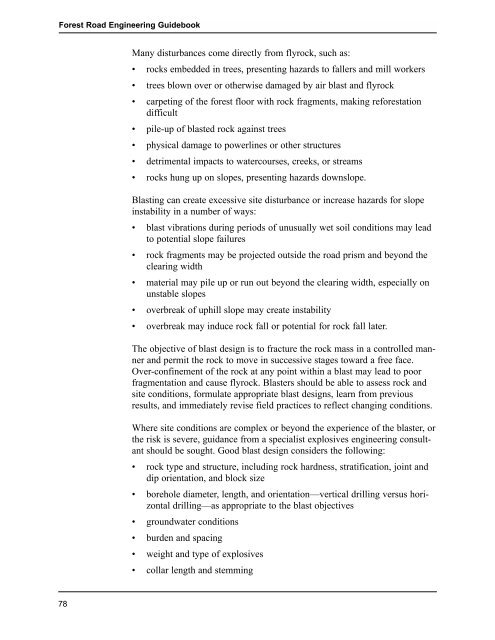Forest Road Engineering Guidebook - Ministry of Forests
Forest Road Engineering Guidebook - Ministry of Forests
Forest Road Engineering Guidebook - Ministry of Forests
Create successful ePaper yourself
Turn your PDF publications into a flip-book with our unique Google optimized e-Paper software.
<strong>Forest</strong> <strong>Road</strong> <strong>Engineering</strong> <strong>Guidebook</strong><br />
78<br />
Many disturbances come directly from flyrock, such as:<br />
• rocks embedded in trees, presenting hazards to fallers and mill workers<br />
• trees blown over or otherwise damaged by air blast and flyrock<br />
• carpeting <strong>of</strong> the forest floor with rock fragments, making reforestation<br />
difficult<br />
• pile-up <strong>of</strong> blasted rock against trees<br />
• physical damage to powerlines or other structures<br />
• detrimental impacts to watercourses, creeks, or streams<br />
• rocks hung up on slopes, presenting hazards downslope.<br />
Blasting can create excessive site disturbance or increase hazards for slope<br />
instability in a number <strong>of</strong> ways:<br />
• blast vibrations during periods <strong>of</strong> unusually wet soil conditions may lead<br />
to potential slope failures<br />
• rock fragments may be projected outside the road prism and beyond the<br />
clearing width<br />
• material may pile up or run out beyond the clearing width, especially on<br />
unstable slopes<br />
• overbreak <strong>of</strong> uphill slope may create instability<br />
• overbreak may induce rock fall or potential for rock fall later.<br />
The objective <strong>of</strong> blast design is to fracture the rock mass in a controlled manner<br />
and permit the rock to move in successive stages toward a free face.<br />
Over-confinement <strong>of</strong> the rock at any point within a blast may lead to poor<br />
fragmentation and cause flyrock. Blasters should be able to assess rock and<br />
site conditions, formulate appropriate blast designs, learn from previous<br />
results, and immediately revise field practices to reflect changing conditions.<br />
Where site conditions are complex or beyond the experience <strong>of</strong> the blaster, or<br />
the risk is severe, guidance from a specialist explosives engineering consultant<br />
should be sought. Good blast design considers the following:<br />
• rock type and structure, including rock hardness, stratification, joint and<br />
dip orientation, and block size<br />
• borehole diameter, length, and orientation—vertical drilling versus horizontal<br />
drilling—as appropriate to the blast objectives<br />
• groundwater conditions<br />
• burden and spacing<br />
• weight and type <strong>of</strong> explosives<br />
• collar length and stemming

















